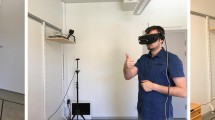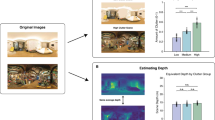Abstract
The ability to locate, select and interact with objects is fundamental to most Virtual Reality (VR) applications. Recently, it was demonstrated that the virtual hand metaphor, a technique commonly used for these tasks, can also be employed to control the virtual camera, resulting in improved performance and user evaluation in visual search tasks.
In this work, we further investigate the effects of hand-assisted viewing on user behavior in immersive virtual environments. We demonstrate that hand-assisted camera control significantly changes the way how people operate their virtual hands, on motor, cognitive, and behavioral levels.
Similar content being viewed by others
References
Biguer, B., Jeannerod, M., Prablanc, P.: The coordination of eye, head and arm movements during reaching at a single visual target. Exp. Brain Res. 46, 301–304 (1982)
Boger, Y.: Are existing head-mounted displays “good enough”? A summary of a worldwide HMD survey on past experience and future expectations from HMDs (2007). http://www.sensics.com/downloads/2007HMDSurveyResults.pdf, accessed on June 19, 2010
Bolas, M., Pair, J., Haynes, K., McDowall, I.: Display research at the University of Southern California. IEEE Emerging Displays Workshop, Alexandria, VA (2006)
Bowman, D., Kruijff, E., LaViola, J., Poupyrev, I.: 3D User Interfaces: Theory and Practice. Addison-Wesley, Reading (2004)
Britton, E., Lipscomb, J., Pique, M.: Making nested rotations convenient for the user. In: Proceedings of SIGGRAPH’78, pp. 222–227 (1978)
Bungert, C.: HMD/Headset/VR-Helmet Comparison Chart. http://www.stereo3d.com/hmd.htm, accessed on June 19, 2010
Jacoby, R., Ferneau, M., Humphries, J.: Gestural interaction in a virtual environment. Stereoscopic displays and virtual reality systems. SPIE 2177, 355–364 (1994)
Jaekl, P., Allison, R., Harris, L., Jasiobedzka, U., Jenkin, H., Jenkin, M., Zacher, J., Zikovitz, D.: Perceptual stability during head movement in virtual reality. In: Proc. IEEE VR, pp. 149–155 (2002)
Jaekl, P., Jenkin, M., Harrisa, L.: Perceptual stability during active head movements orthogonal and parallel to gravity. J. Vestib. Res. 13, 265–271 (2003)
Jay, C., Hubbold, J.: Amplifying head movements with head-mounted displays. Presence 12, 268–276 (2003)
Kiyokawa, K.: A wide field-of-view head mounted projective display using hyperbolic half-silvered mirrors. In: Proceedings of ISMAR’07, Nara, Japan (2007)
Land, M.: Eye movements in daily life. In: Calupa, L., Werner, J. (eds.) The Visual Neurosciences, vol. 2, pp. 1357–1368. MIT Press, New York (2004)
Hinckley, K., Tullio, J., Pausch, R., Proffitt, D., Kassell, N.: Usability analysis of 3D rotation techniques. In: UIST ’97: Proceedings of the 10th Annual ACM Symposium on User Interface Software and Technology, pp. 1–10. ACM Press, New York (1997)
LaViola Jr., J., Feliz, D., Keefe, D., Zeleznik, R.: Hands-free multi-scale navigation in virtual environments. In: Proceedings of ACM SIGGRAPH I3D Symposium on Interactive 3D Graphics, North Carolina (2001)
LaViola, J., Forsberg, A., Huffman, J., Bragdon, A.: The influence of head tracking and stereo on user performance with non-isomorphic 3D rotation. In: Proceedings of the 14th Eurographics Symposium on Virtual Environments, pp. 111–118 (2008)
LaViola, J., Katzourin, M.: An exploration of non-isomorphic 3D rotation in surround screen virtual environments. In: Proceedings of the IEEE Symposium on 3D UI, pp. 49–54 (2007)
Neale, D.: Head-mounted displays: product reviews and related design considerations. Hypermedia Technical Report HCIL-98-02, Human–Computer Interaction Laboratory, Department of Industrial and Systems Engineering, Virginia Tech, Blacksburg, VA 24061-0118 (1998)
Poupyrev, I., Billinghurst, M., Weghorst, S., Ichikawa, T.: The go-go interaction technique: non-linear mapping for direct manipulation in VR. In: Proceedings of ACM UIST, pp. 79–80 (1996)
Poupyrev, I., Weghorst, S., Fels, S.: Non-isomorphic 3D rotational techniques. In: Proceedings of CHI’2000, pp. 540–547 (2000)
Rosenbaum, D.: Human Motor Control, pp. 253–264. Academic Press, New York (1991)
Sherstyuk, A., Vincent, D., Hwa Lui, J., Connolly, K., Wang, K., Saiki, S., Caudell, T.: Design and development of a pose-based command language for triage training in virtual reality. In: Proceedings of IEEE 3DUI (2007)
Sherstyuk, A., Vincent, D., Jay, C.: Sliding viewport for interactive virtual environments. In: Proceedings of ICAT, Yokohama, Dec. 1–3 (2008)
The Homunculus Project. http://www.hpc.unm.edu/homunculus, accessed on June 19, 2010
Vincent, D., Sherstyuk, A., Burgess, L., Connoly, K.: Teaching mass casualty triage skills using immersive 3D virtual reality. Acad. Emerg. Medicine J. 15(11), 1160–1165 (2008)
Author information
Authors and Affiliations
Corresponding author
Rights and permissions
About this article
Cite this article
Sherstyuk, A., Jay, C. & Treskunov, A. Impact of hand-assisted viewing on user performance and learning patterns in virtual environments. Vis Comput 27, 173–185 (2011). https://doi.org/10.1007/s00371-010-0516-0
Published:
Issue Date:
DOI: https://doi.org/10.1007/s00371-010-0516-0




